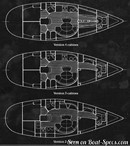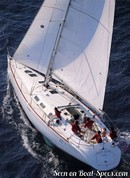First 42s7 Lead keel
Sailboat specifications
The First 42s7 is a 41’8” (12.7m) cruiser-racer sailboat designed by Farr Yacht Design (United States). She was built since 1994 (and now discontinued) by Bénéteau (France). The Lead keel version offers a deeper L-shaped keel bringing extra performance especially upwind.
The First 42s7 is as well listed, on Boat-Specs.com, in Shoal draft version (see all the versions compared).
The First 42s7 is as well listed, on Boat-Specs.com, in Shoal draft version (see all the versions compared).
First 42s7's main features
- Model
- First 42s7
- Version
- Lead keel
- Hull type
- Monohull
- Category
- Offshore cruiser-racer sailboat
- Sailboat builder
- Sailboat designer
- Sailboat range
- Country
- France
- Construction
- GRP (glass reinforced polyester):
- Hull: Single skin fiberglass polyester
- Deck: Sandwich balsa fiberglass polyester - First built hull
- 1994
- Last built hull
- Discontinued
- Appendages
- Keel : L-shaped keel (with bulb)
- Helm
- Single helm wheel
- Rudder
- Single spade rudder
- Unsinkable
- No
- Trailerable
- No
- Former French navigation category
- 1
- Standard public price ex. VAT (indicative only)
- N/A €
First 42s7's main dimensions
- Overall length
- 42’ 6”12.95 m
- Hull length
- 41’ 8”12.7 m
- Waterline length
- 35’ 10”10.9 m
- Beam (width)
- 13’ 6”4.12 m
- Draft
- 7’ 6”2.3 m
- Light displacement (MLC)
- 18739 lb8500 kg
- Ballast weight
- 6173 lb2800 kg
- Ballast type
- Lead
First 42s7's rig and sails
- Upwind sail area
- 1033 ft²95.97 m²
- Downwind sail area
- 1705 ft²158.42 m²
- Mainsail area
- 467 ft²43.42 m²
- Genoa area
- 566 ft²52.55 m²
- Symmetric spinnaker area
- 1238 ft²115 m²
- Rigging type
- Sloop Marconi 7/8
- Mast configuration
- Keel stepped mast
- Rotating spars
- No
- Number of levels of spreaders
- 2
- Spreaders angle
- 14 °
- Spars construction
- Aluminum spars
- Standing rigging
- 1x19 strand wire
First 42s7's performances
- Upwind sail area to displacementiThe ratio sail area to displacement is obtained by dividing the sail area by the boat's displaced volume to the power two-thirds.
The ratio sail area to displacement can be used to compare the relative sail plan of different sailboats no matter what their size.
Upwind: under 18 the ratio indicates a cruise oriented sailboat with limited performances especially in light wind, while over 25 it indicates a fast sailboat. - 248 ft²/T23.04 m²/T
- Downwind sail area to displacementiThe ratio sail area to displacement is obtained by dividing the sail area by the boat's displaced volume to the power two-thirds.
The ratio sail area to displacement can be used to compare the relative sail plan of different sailboats no matter what their size. - 409 ft²/T38.04 m²/T
- Displacement-length ratio (DLR)iThe Displacement Length Ratio (DLR) is a figure that points out the boat's weight compared to its waterline length. The DLR is obtained by dividing the boat's displacement in tons by the cube of one one-hundredth of the waterline length (in feet).
The DLR can be used to compare the relative mass of different sailboats no matter what their length:
a DLR less than 180 is indicative of a really light sailboat (race boat made for planning), while a DLR greater than 300 is indicative of a heavy cruising sailboat. - 186
- Ballast ratioiThe Ballast ratio is an indicator of stability; it is obtained by dividing the boat's displacement by the mass of the ballast. Since the stability depends also of the hull shapes and the position of the center of gravity, only the boats with similar ballast arrangements and hull shapes should be compared.
The higher the ballast ratio is, the greater is the stability. - 33 %
- Critical hull speediAs a ship moves in the water, it creates standing waves that oppose its movement. This effect increases dramatically the resistance when the boat reaches a speed-length ratio (speed-length ratio is the ratio between the speed in knots and the square root of the waterline length in feet) of about 1.2 (corresponding to a Froude Number of 0.35) . This very sharp rise in resistance, between speed-length ratio of 1.2 to 1.5, is insurmountable for heavy sailboats and so becomes an apparent barrier. This leads to the concept of "hull speed".
The hull speed is obtained by multiplying the square root of the waterline length (in feet) by 1.34. - 8.01 knots
First 42s7's auxiliary engine
- Engine(s)
- 1 inboard engine
- Engine(s) power (min./max.)
- 48 HP / 72 HP
- Fuel type
- Diesel
- Fuel tank capacity
- 39.6 gal150 liters
First 42s7's accommodations and layout
- Cockpit
- Closed aft cockpit
- Cabin(s) (min./max.)
- 2 / 4
- Berth(s) (min./max.)
- 4 / 8
- Head(s)
- 2
- Freshwater tank capacity
- 171.7 gal650 liters
- Fridge/ice-box capacity
- 44.9 gal170 liters
- Boiler capacity
- 11.1 gal42 liters
- Maximum headroom
- 6’ 5”1.96 m
First 42s7's fore cabin
- Berth length
- 6’ 5”1.95 m
- Berth width
- 4’ 10”1.45 m
First 42s7's aft cabin
- Berth length
- 6’ 7”2 m
- Berth width (head/feet)
- 4’ 10”1.45 m / 4’1.23 m








Bénéteau First 42s7 interior and accommodations - - 7/8
Picture extracted from the commercial documentation © Bénéteau
Picture extracted from the commercial documentation © Bénéteau


Bénéteau First 42s7 interior and accommodations - - 8/8
Picture extracted from the commercial documentation © Bénéteau
Picture extracted from the commercial documentation © Bénéteau
Similar sailboats that may interest you:
Sailboats
First built hull
Hull length
1989
41’12.5 m
2008
40’ 2”12.24 m
2006
42’ 6”12.95 m
2004
43’ 10”13.35 m
1990
45’ 7”13.9 m
1988
52’ 6”16 m
2003
42’ 5”12.93 m
1989
40’ 5”12.3 m
1998
42’ 7”12.98 m
2017
40’12.2 m
1994
41’ 8”12.7 m
1997
39’ 1”11.92 m
1996
40’ 10”12.45 m
1990
40’ 2”12.25 m
2007
40’ 4”12.27 m